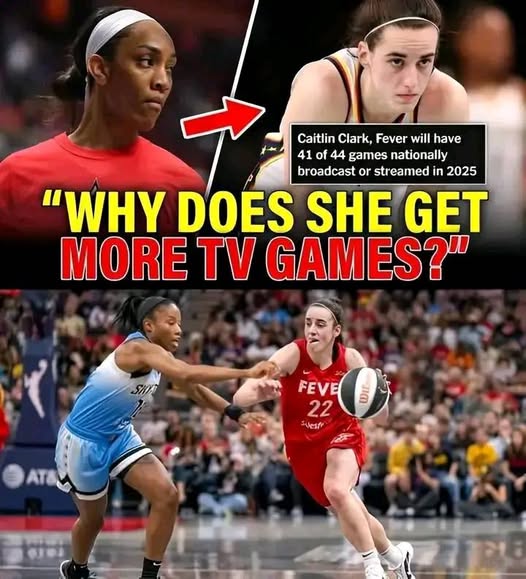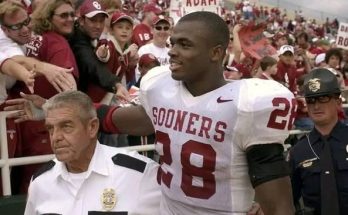In the ever-evolving world of the WNBA, where fierce competition on the court often leads to moments of intense passion and rivalry off it, the spotlight rarely shines brighter than when two of the league’s brightest stars cross paths. A’Ja Wilson, the 2020 WNBA MVP and cornerstone of the Las Vegas Aces, has solidified herself as one of the best players in the world. Caitlin Clark, the electrifying guard from the University of Iowa, has taken the basketball world by storm, garnering a level of media attention that has made her a household name far beyond the confines of women’s college basketball.
However, in an alternate universe where the narrative of women’s sports becomes a battleground for media coverage and public perception, imagine a scenario in which A’Ja Wilson finds herself furious about the disproportionate media attention that Caitlin Clark receives, particularly regarding national TV games and the Indiana Fever’s new focus on promoting her as the face of their franchise. This imagined rivalry provides a rich backdrop for exploring themes of media bias, personal rivalry, and the struggles of balancing individual ambition with team dynamics in an increasingly commercialized sport.
Chapter 1: The Media Landscape
The rise of Caitlin Clark in college basketball has been nothing short of meteoric. Her scoring ability, playmaking skills, and leadership on the floor have made her the poster child for the future of women’s sports. Her long-range shooting prowess, coupled with her fearless attitude, quickly transformed her into a star, both on and off the court. By the time she entered the WNBA Draft, she was already a household name, with millions of fans eagerly anticipating her transition to the professional ranks.
In contrast, A’Ja Wilson had already been a dominant force in the WNBA for several years. After winning Rookie of the Year in 2018, Wilson went on to become the cornerstone of the Las Vegas Aces, leading them to the WNBA Finals in 2020 and eventually securing the MVP award in the same year. Her powerful play in the post, her leadership on defense, and her ability to stretch the floor as a big were vital to the Aces’ success. Yet, despite her achievements, Wilson’s media presence often felt underwhelming compared to the hype surrounding newer stars like Clark.
This disparity in media coverage becomes a key point of contention in our imagined scenario. The media landscape in sports is often influenced by marketability, with the likes of Caitlin Clark, a player who’s been able to generate massive attention for women’s college basketball, garnering significant television contracts and national endorsement deals. But in this imagined version of events, the conversation takes a different turn as Wilson begins to feel overshadowed by Clark’s meteoric rise, especially when the WNBA opts to feature Indiana Fever games—now centered around Clark—as a key part of their national TV broadcast schedule.
Chapter 2: The National TV Games Battle
The WNBA, aware of the growing public interest in Caitlin Clark and eager to capitalize on her star power, prioritizes her games. This decision leads to an influx of national TV slots being given to the Indiana Fever, a team that is rebuilding and looking to build around Clark’s undeniable star power. For players like A’Ja Wilson, who have dedicated years to the league and helped build it into the premier women’s professional basketball platform it is today, the decision feels like a slight. With Clark being a rookie, the question arises: Is the WNBA’s desire for a larger media presence and broader audience worth sidelining established stars like Wilson, who have already proven their value?
A’Ja Wilson is not one to hold back her feelings. Known for her passionate play on the court, she channels that same intensity into her frustrations off the court. Through private conversations with teammates, coaches, and fellow players, the whispers grow louder. There is talk of a potential boycott—a stand against the media monopolization of Clark’s image at the expense of players who have been the league’s foundation. A’Ja’s frustration isn’t just about the media’s focus on Clark; it’s about what she perceives as a disregard for the players who’ve paved the way for the WNBA’s growth.
The Las Vegas Aces, with Wilson at the helm, are one of the league’s most successful franchises. They’re led by one of the most dominant players in the game. Yet, despite this, it seems the media’s gaze is fixed on the Fever’s new golden girl, Clark. A’Ja’s frustration intensifies as she watches Clark, in her first year, land more and more prime-time games, while the Aces, despite their success, seem to be relegated to second-tier television slots.
Chapter 3: The Stirring of Rivalries
As A’Ja’s frustration mounts, a rivalry between the two players begins to simmer beneath the surface. On the court, A’Ja Wilson and Caitlin Clark have yet to meet in the WNBA, but there’s no denying that their potential matchups would be must-watch TV. Clark’s dynamic scoring and playmaking against Wilson’s dominant post play and leadership would provide the perfect contrast of styles. But beyond the basketball aspect, the media frenzy around Clark has created a narrative in which Wilson feels as if she is no longer in control of her story.
This imaginary scenario feeds into the age-old issue of athletes feeling the pressure to uphold an image dictated by external forces. A’Ja Wilson’s narrative has been about overcoming challenges, working tirelessly to lead her team, and achieving greatness. Caitlin Clark’s narrative, on the other hand, has been one of instant stardom, making her an icon before even stepping onto a WNBA court. As much as Wilson admires Clark’s talent, it’s impossible to ignore the sting of feeling like the league is placing more value on the future than the present.
Meanwhile, Clark—emboldened by the overwhelming media attention and her rookie-year success—begins to embrace her role as the face of the Indiana Fever and the WNBA’s newest darling. But there’s a palpable tension in the air. Will Clark’s rise come at the expense of Wilson’s legacy? Will the rivalry between these two incredible players become the centerpiece of the WNBA’s future, or will the media focus on Clark’s “untouchable” status overshadow the veteran leadership that Wilson represents?
Chapter 4: The Fallout and the Media’s Role
As the season progresses, the media continues to cover the feud—both real and perceived—between A’Ja Wilson and Caitlin Clark. Speculation runs rampant on social media, with fans of both players staking their claims. Some rally behind A’Ja, arguing that she deserves more respect and recognition for her contributions to the league. Others cheer for Clark, thrilled by her brash confidence and exceptional skill on the court. The media, ever quick to capitalize on drama, fans the flames, creating a narrative that pits two of the game’s brightest stars against one another in an all-out battle for the spotlight.
But the true villain in this story, if there is one, isn’t the players. It’s the system—the media, the league, and the commercial interests that dictate which players get the most attention. A’Ja Wilson, though one of the best players in the world, feels the weight of an industry that prioritizes marketability over substance. And Caitlin Clark, while incredibly talented and deserving of attention, finds herself in a position where the expectations placed upon her are almost unfair.
Chapter 5: Resolution or Escalation?
In this hypothetical scenario, the question remains: Will this rivalry simmer down, or will it escalate into something more significant? The answer lies not only in the actions of A’Ja Wilson and Caitlin Clark but in how the WNBA, the media, and the fans choose to respond.
For Wilson, this situation could serve as a catalyst for greater dialogue about the needs of veteran players in the league and the balance between star power and team success. For Clark, it could be a learning experience in handling the pressures of stardom and understanding the sacrifices made by players who came before her. The resolution, if there is one, could lie in both players finding common ground and recognizing that their rivalry only strengthens the league, bringing more attention to the women’s game as a whole.
The media, in turn, would need to evolve. Rather than pit these two incredible athletes against one another, they could choose to highlight the unique strengths of each player, showing how their individual journeys intersect and complement each other. After all, it’s the combined brilliance of players like A’Ja Wilson and Caitlin Clark that will continue to shape the future of women’s basketball.



